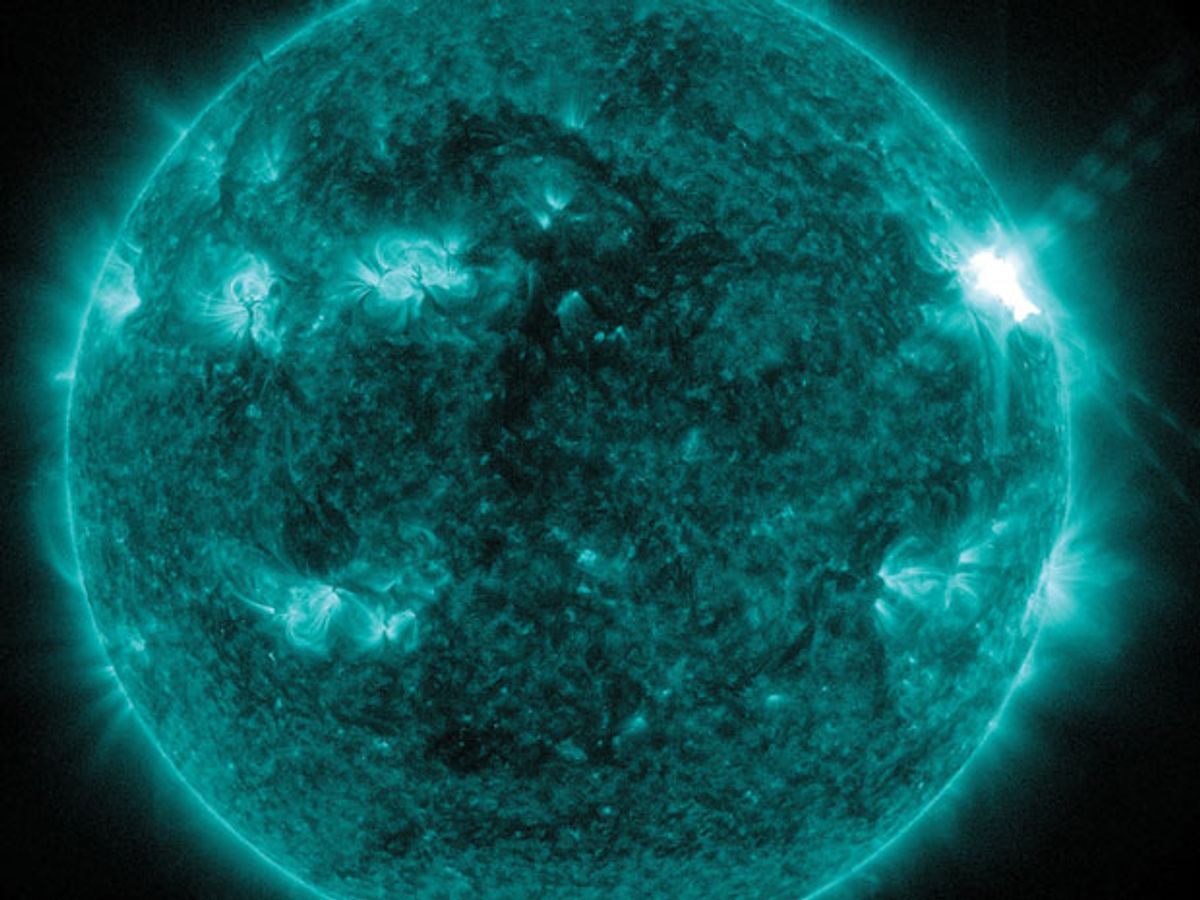It can happen: Every so often the sun emits an explosive burst of charged particles that makes its way to Earth and, under just the right conditions, wreaks havoc on power grids. A powerful geomagnetic storm in March 1989 blacked out the entire province of Quebec, leaving millions of customers in the dark and damaging transformers as far south as New Jersey. Lately the question being debated in space weather circles is: Are we prepared for a repeat, or a storm 10 times worse—like the 1859 solar superstorm?
Thanks to two new satellites, we might be better prepared than ever. The Deep Space Climate Observatory [pdf], which will measure the solar wind at the Sun-Earth L1 Lagrange point, some 1.5 million kilometers from Earth, is set for launch next year. L1 is a gravitational sweet spot ideal for observing the sun because it’s never shadowed by the moon or Earth. Also slated for 2014 is an experimental solar-sail mission dubbed Sunjammer, which will fly more than a million kilometers closer to the sun than L1 and could become the basis for a space-weather early-warning system.
The Deep Space Climate Observatory (DSCOVR) began life 15 years ago, as an Earth-observing satellite called Triana [pdf] that was championed by then vice president Al Gore. But the nearly complete satellite was grounded by politics and a change in administration. “So we just put it in a clean-room container, under nitrogen purge,” says Adam Szabo of NASA’s Goddard Space Flight Center, who is project scientist for DSCOVR.
It wasn’t forgotten, though. The United States’ National Oceanic and Atmospheric Administration (NOAA), which is in charge of issuing space weather forecasts, had long sought a dedicated satellite for such work but lacked the funding. Triana seemed like an inexpensive solution: It was already built, it had instruments on board for measuring solar wind, and the Air Force agreed to pay for the launch, aboard a SpaceX Falcon 9 rocket.
Last fall NASA engineers began refurbishing the satellite. “We completely took it apart,” Szabo says. “Every bit was removed, every subsystem and component was checked.” Most were okay, he says, but a couple of parts were suspect. “Good thing we didn’t launch with those.” This spring, they’re reassembling the satellite, and then they’ll subject it to a battery of testing and verification. The earliest possible launch date is November 2014, he says, but the satellite has to be ready a year before that. Once it is on orbit, NASA will turn it over to NOAA.
To keep costs in check, no new instruments are being added to DSCOVR, despite the change in its job description. The satellite already had a flux-gate magnetometer and a Faraday cup. The cup scoops up protons and measures the particles’ velocity, temperature, and density. Meanwhile, the magnetometer determines the vector of the solar magnetic field.
Measurements from DSCOVR will be intercepted by ground stations and piped to NOAA’s Space Weather Prediction Center in Boulder, Colo. There, automated software will process the data within seconds and turn them into “actionable information,” Szabo says. “It cannot be more than 5 minutes between measurement on the spacecraft and when an operator in Boulder picks up the phone or sends out an e-mail warning. That’s a tall order.”
Also in the works is Sunjammer, being built by L’Garde, of Tustin, Calif., as a way to provide even earlier warnings. Named for the Arthur C. Clarke story of the same name, the spacecraft boasts a 0.1-hectare solar sail that’s designed to let the craft fly toward the sun using the inherent pressure of photons, explains Doug Biesecker, an astrophysicist at the Space Weather Prediction Center. Among other things, researchers hope to learn whether the giant sail will interfere with solar wind measurements.
Space weather experts agree that such projects are absolutely necessary—and not enough. At present, several of the key spacecraft NOAA relies on have exceeded their operational lifetimes, including the Solar and Heliospheric Observatory and the Advanced Composition Explorer (ACE). DSCOVR will replace the 15-year-old ACE but won’t expand much on its capabilities. And Sunjammer is only a demonstration; no follow-ons have been funded.
In a perfect world, direct observations of the sun would translate into detailed alerts describing what the magnetic field will look like when it reaches Earth, where and when the storm will strike, and which grid components will be at most risk. That information would give grid operators several days to prepare. Today’s forecasts offer only about 30 to 45 minutes of lead time.
Space watchers will note that these spacecraft will launch well after the current solar cycle has peaked. But the next great geomagnetic event could happen at any time. “The size of a solar cycle does not determine the size of space weather storms, only the frequency,” says Biesecker. “So you could have fewer storms but just as severe, or more so.”
Right now, interest in this area is high, notes Rich Lordan of the Electric Power Research Institute, in Palo Alto, Calif., whose electric utility members fund about $2 million annually in geomagnetic storm research. “It tends to follow the solar cycle.” The trick, he says, is to keep the momentum going. “Let’s finish [the work], let’s not stop—as a gift to the people who will be running things 11 years from now.”
